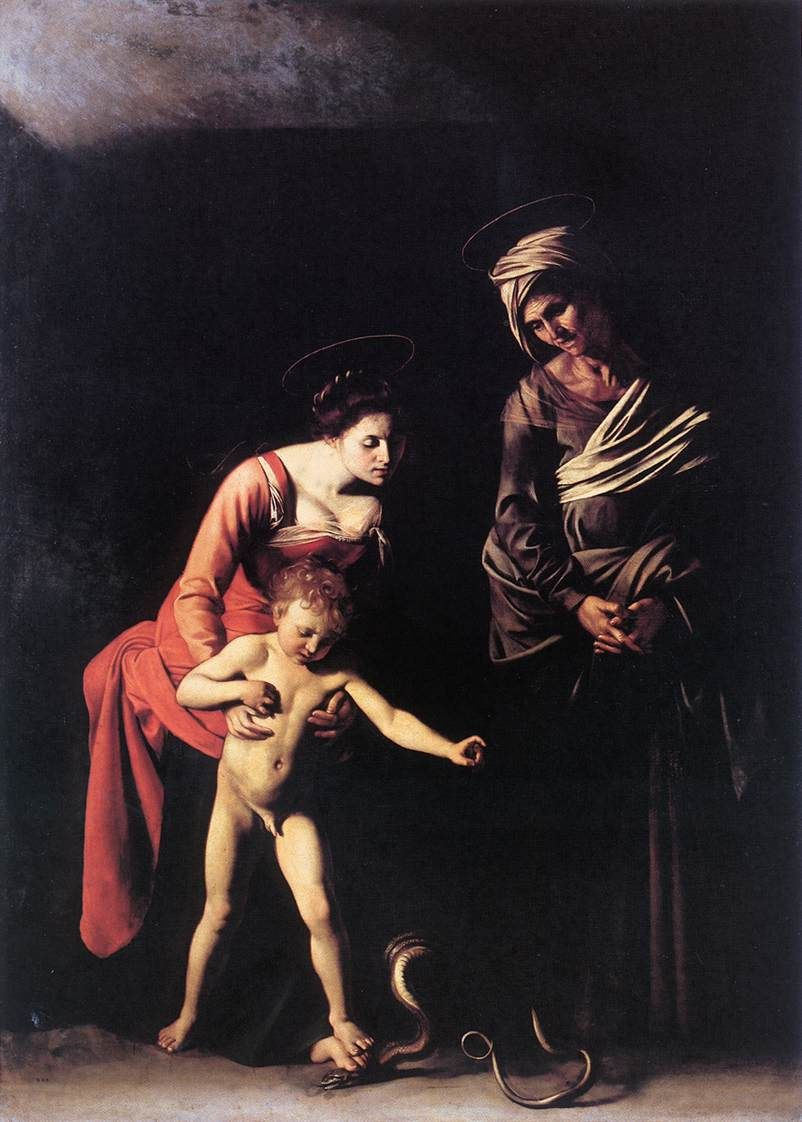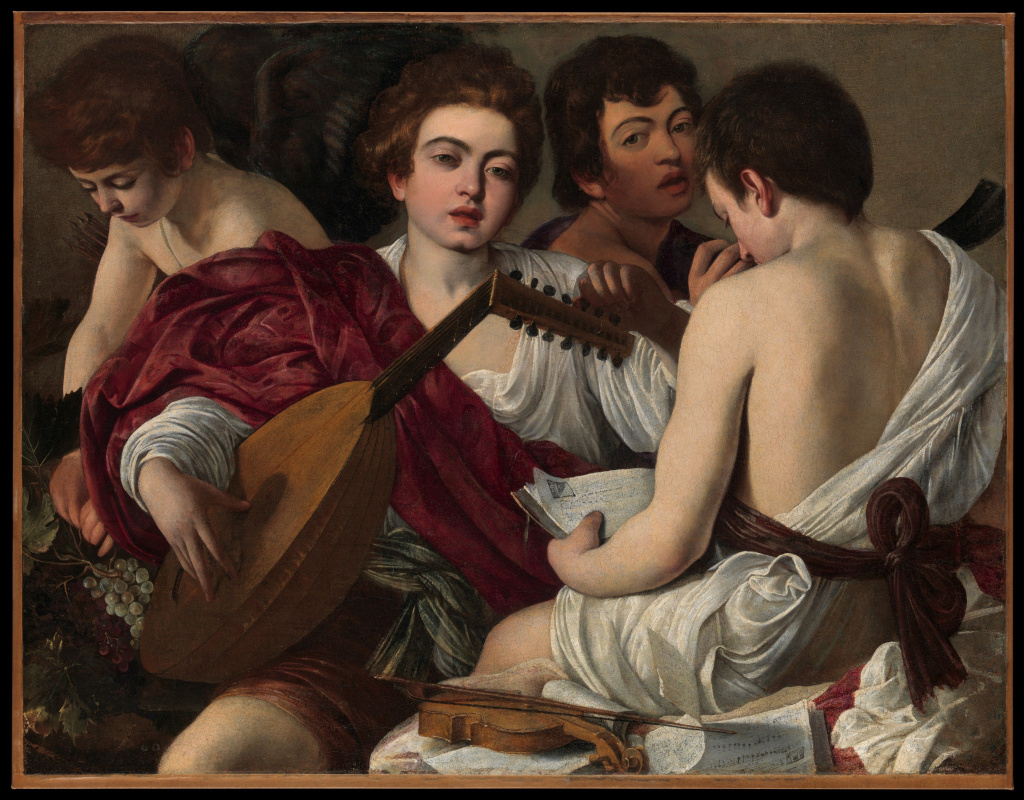Hardly any artist of the past had as many jokes and scandalous gossip going around as Michelangelo Merisi da Caravaggio. Strictly speaking, most of his life can be described using the scheme: "Once Caravaggio scrapped with…". Instead of the points of ellipsis, there can be "his employer, his model, his teacher, his drinking companion, the priest, his colleague, his mistress, his lover, the guards, his landlady…" - the list is endless. It’s amazing how he managed to paint in between those quarrels (though some of his paintings became a reason for another fight).

The model for the boy in this painting (Boy with a Basket of Fruit, 1593) was allegedly Mario Minniti — Caravaggio’s pupil, model and lover. Despite Michelangelo’s short temper, Mario stayed with him for quite a long time, but the couple fell out after the artist announced his decision to marry. However, when it comes to your old lover preferring a woman to you, the quarrel is hardly surprising.
Let’s see what else could cause a conflict with Caravaggio.
Here we go!
Once Caravaggio ran foul with the artist Giovanni Baglione because Michelangelo and his friends wrote poems in mockery of the painter and called him "Johnny Bollock" and "a cuckold worthy only of painting’s vituperation." As a result, Baglione sued Caravaggio and his friends for libel. Though he won the case, the punishment wasn’t serious.
By the way, Baglione outlived Caravaggio and managed to take revenge on his opponent by writing his biography.
Here we go!
Once Caravaggio ran foul with the artist Giovanni Baglione because Michelangelo and his friends wrote poems in mockery of the painter and called him "Johnny Bollock" and "a cuckold worthy only of painting’s vituperation." As a result, Baglione sued Caravaggio and his friends for libel. Though he won the case, the punishment wasn’t serious.
By the way, Baglione outlived Caravaggio and managed to take revenge on his opponent by writing his biography.

Giovanni Baglione. Sacred Love and Profane Love, 1602
Looking at how Baglione followed the laws of composition and proportions, one can understand why Caravaggio called him "worthy only of painting’s vituperation."
Or once Caravaggio had a fight with a waiter who couldn’t tell him which of the artichokes were cooked in butter and which — fried in oil.
When the waiter told him to smell them, which would easily enable him to tell the difference, the artist threw the whole plate of artichokes in his face and reached for a sword.
The waiter had a point, though — a man who created beautiful still lifes, could have figured out himself, which oil was used for cooking…
When the waiter told him to smell them, which would easily enable him to tell the difference, the artist threw the whole plate of artichokes in his face and reached for a sword.
The waiter had a point, though — a man who created beautiful still lifes, could have figured out himself, which oil was used for cooking…
Supper at Emmaus
1602, 139×195 cm
Everywhere he went, Caravaggio wore a sword and even got into trouble for carrying it without a permit. For example, one day Caravaggio was taking a walk after dark, carrying his sword and dagger, and met a police patrol under the command of the brave Captain Pino. When the latter requested to see Caravaggio’s permit to carry weapons, the artist admitted he only had an oral one, given by Rome’s governor himself.
Judging by the fact that the artist was released from prison and given his weapons back, the Roman authorities treated his armed walks with indulgence.
However, when Caravaggio was actually able to produce a permit, the artist was jailed for insulting a police corporal, shouting: "you and all those who are with you can shove it."
Judging by the fact that the artist was released from prison and given his weapons back, the Roman authorities treated his armed walks with indulgence.
However, when Caravaggio was actually able to produce a permit, the artist was jailed for insulting a police corporal, shouting: "you and all those who are with you can shove it."
The taking of Christ into custody
1602, 169×133 cm
We wonder whether this painting depicts some sbirro (a police officer in Italy) who arrested the artist.
By the way, some Roman citizens believed that it was better not to give Caravaggio anything sharper than a toothpick (regardless of the permit), since the artist was too impetuous.
For example, once Caravaggio had a fight with a notary Mariano Pasqualone who had the imprudence to talk to him about "that girl Lena" (a courtesan Maddalena Antonietti, Caravaggio’s model and lover). After that, walking in the Piazza Navona in the evening, Pasqualone was attacked from behind and wounded by a sword or dagger blow to the back of his head. Although the notary didn’t see the attacker, he was sure that it was Caravaggio.
For example, once Caravaggio had a fight with a notary Mariano Pasqualone who had the imprudence to talk to him about "that girl Lena" (a courtesan Maddalena Antonietti, Caravaggio’s model and lover). After that, walking in the Piazza Navona in the evening, Pasqualone was attacked from behind and wounded by a sword or dagger blow to the back of his head. Although the notary didn’t see the attacker, he was sure that it was Caravaggio.
The Madonna and child with Saint Anne
1606, 292×211 cm
It is believed that the model for Madonna in this (and not only this) painting was Maddalena Antonietti.
It is no wonder Caravaggio had arguments with some corporals and lascivious notaries… once he had a fight with his own brother (probably when dividing their inheritance)! Their fight was so big that, having moved to Rome to his patron Cardinal del Monte, the artist told him that he had no relatives. To Caravaggio’s dismay, his brother (who was a priest) went to Rome, decided to visit his relative and came to the cardinal’s palace. His Eminence, slightly confused by the brothers' relations, decided to make them confront each other. The priest then brought Michelangelo greetings from his sister and promised to remember him in his prayers, but Caravaggio kept saying: "I see this priest for the first time."
Musicians
1595, 92.1×118.4 cm
The painting Musicians was commissioned to Caravaggio by Cardinal Francesco del Monte.
Shortly after the incident with his brother, Caravaggio left the cardinal’s villa and moved into the house of the banker and collector Ciriaco Mattei, who bought his Fortune Teller.
Tired of living with patrons of art, Caravaggio finally rented a house and, of course, fell out with his landlady because of not paying his rent for six months and not fixing the ceiling in the room, which served as his studio. When the landlady decided to take the property Caravaggio left behind, he had another fight with her and threw stones at her windows.
Tired of living with patrons of art, Caravaggio finally rented a house and, of course, fell out with his landlady because of not paying his rent for six months and not fixing the ceiling in the room, which served as his studio. When the landlady decided to take the property Caravaggio left behind, he had another fight with her and threw stones at her windows.
Saint Jerome in Thought
1606, 118×81 cm
Caravaggio needed the dismantled ceiling to get his favourite type of lighting where a great beam of light would bisect his composition diagonally.
Moreover, Caravaggio had a really bad fight with Ranuccio Tomassoni over a ball game. As a result, Tomassoni received a mortal wound (some biographers specify that the artist tried to castrate his opponent, but managed only to murder him), and Caravaggio had to flee Rome. By the way, the biographers still have not decided what exactly caused that quarrel — the game results, Tomassoni’s phrase "I want to put my horn up her [Lena] so that you’ll have the horns of a cuckold on your head" or his sister, whose portrait Caravaggio allegedly painted.
Escaping from court, Caravaggio left for Malta, where he was accepted into the Order of Saint John (the Knights of Malta) due to the masterpieces he painted there, but one day the artist had a fight with the other knights, was imprisoned (of course, he did not wait for his trial and escaped from Malta) and lost his membership in the brotherhood.
Escaping from court, Caravaggio left for Malta, where he was accepted into the Order of Saint John (the Knights of Malta) due to the masterpieces he painted there, but one day the artist had a fight with the other knights, was imprisoned (of course, he did not wait for his trial and escaped from Malta) and lost his membership in the brotherhood.
Portrait'alofa de Vignancour
1608, 195×134 cm
Alof de Wignacourt, Grand Master of the Order of Malta, loved this portrait to such a degree he gave him (apart from the agreed fee) a lot of presents, including a gold chain and two slaves.
Working in Messina, Caravaggio had a fight with his models who didn’t want to pose for his Resurrection of Lazarus holding up a decaying corpse. Without much ado, Caravaggio took his dagger and forced them to continue posing.
The Resurrection Of Lazarus
1609, 380×275 cm
Strictly speaking, there is an assumption that the boat that took Caravaggio’s paintings, but did not wait for their author, left for a reason: the artist’s patrons got a little tired of protecting the person causing so much trouble. If they had brought him back to Rome, they would have immediately heard another: "Caravaggio scrapped with…".
Author: Oksana Sanzharova
Author: Oksana Sanzharova
































